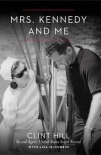Mrs. Kennedy and Me: An Intimate Memoir, Clint Hil [large ebook reader TXT] 📗

- Author: Clint Hil
Book online «Mrs. Kennedy and Me: An Intimate Memoir, Clint Hil [large ebook reader TXT] 📗». Author Clint Hil
I reached out my hand and touched her elbow.
“You know about the bomb shelter here, under the White House. I know that J. B. West gave you a brief tour of the facility a few months ago . . .”
I just had to state the facts.
“In the event . . . a situation develops . . . where we don’t have time to leave the area, we would take you and the children into the shelter for protection.”
Before I could explain any further, she pulled away from me, in what can only be described as defiance, and said, “Mr. Hill, if the situation develops that requires the children and me to go to the shelter, let me tell you what you can expect.”
She was looking me straight in the eyes. She lowered her voice, into a deep whisper, and with complete and utter conviction said, “If the situation develops,” she repeated, “I will take Caroline and John, and we will walk hand in hand out onto the south grounds. We will stand there like brave soldiers, and face the fate of every other American.”
I was not completely surprised by her response, but hearing her say it out loud made me realize what I would have to do, should we get to the point that moving her and the children into the bomb shelter was the directive.
I knew then and there that, should that occasion arise, she may or may not have forgiven me, but I would have picked her up, wherever we were, and into the shelter we would have gone. As long as I was responsible for her protection, nothing else mattered.
But instead I said, “Well, Mrs. Kennedy, let’s just pray to God that we will never be in that situation.”
DURING THE NEXT few days the situation was very tense. The president and Mrs. Kennedy tried to maintain a regular schedule to make everything appear normal. The president traveled to Bridgeport, Waterbury, and New Haven, Connecticut, returning the same day. At the White House, he would pop in and out of the Cabinet Room, where the National Security Council’s Executive Committee, or ExComm, was secretly meeting, and at one point he had a meeting with Foreign Minister Andrei Gromyko and Ambassador Anatoly Dobrynin of the USSR.
On Friday, October 19, I took Mrs. Kennedy, John, and Caroline to Glen Ora—as was our normal weekend routine when we were in Washington—while the president traveled to Cleveland; Springfield, Illinois; and Chicago.
On Saturday morning, October 20, 1962, Mrs. Kennedy came to me and said, “Mr. Hill, the president just called and he is on his way back from Chicago. He wants the children and me to return to the White House. Will you arrange for a helicopter?”
This was highly unusual, so I knew something must have happened with the negotiations. Why would the president be leaving Chicago early? And why the urgent need for a helicopter when we could easily drive back?
“Of course, Mrs. Kennedy.”
When I called for the helicopter, I found out that indeed the president had left Chicago early—due to a “bad cold.”
I knew damn well the president didn’t have a cold, and never before had he requested Mrs. Kennedy to return to the White House from Glen Ora.
ADDITIONAL PHOTOS AND analysis had concluded that the Soviets were readying fighter jets and bombers and were assembling cruise missile launchers. Additionally, there was evidence that SS-5 missiles were being assembled, which were capable of reaching anywhere in the continental United States. President Kennedy decided it was time to alert the American public that we were facing a chilling crisis. There was no more time for discussion. He had to make a final decision on military options. On Monday evening, October 22, from his desk at the Oval Office, the president appeared on live television and radio and somberly laid out the indisputable evidence that had been gathered over the past six days. In the seventeen-minute address he gave Khrushchev an ultimatum to “halt and eliminate this clandestine, reckless and provocative threat to world peace and to stable relations between our two nations” or else the United States would, justifiably, take military action.
Looking into the cameras, the president stated, “I have directed the armed forces to prepare for any eventualities; and I trust that in the interest of both the Cuban people and the Soviet technicians at the sites, the hazards to all concerned in continuing this threat will be recognized.”
He outlined the immediate steps the United States was taking, including a strict “quarantine”—essentially a blockade—on all ships containing cargoes of offensive weapons, as well as a request for an emergency meeting of the Security Council of the United Nations.
He ended the solemn address with this: “My fellow citizens, let no one doubt that this is a difficult and dangerous effort on which we have set out . . . but the greatest danger of all would be to do nothing.
“The path we have chosen for the present is full of hazards, as all paths are—but it is the one most consistent with our character and courage as a nation and our commitments around the world. The cost of freedom is always high—and Americans have always paid it. And one path we shall never choose, and that is the path of surrender or submission.
“Our goal is not the victory of might, but the vindication of right—not peace at the expense of freedom, but both peace and freedom, here in this hemisphere, and, we hope, around the world. God willing, that goal will be achieved.
“Thank you and good night.”
THE READINESS OF the defense establishment, a state commonly referred to as DEFCON, for “Defense Condition,” is noted by a numbering system that indicates the severity of the situation. DEFCON 5 is the least severe condition, while DEFCON 1 means a nuclear war is imminent. On October 22, a DEFCON 3 was ordered for the entire military establishment, meaning an increase in readiness from that which is normal. The





Comments (0)